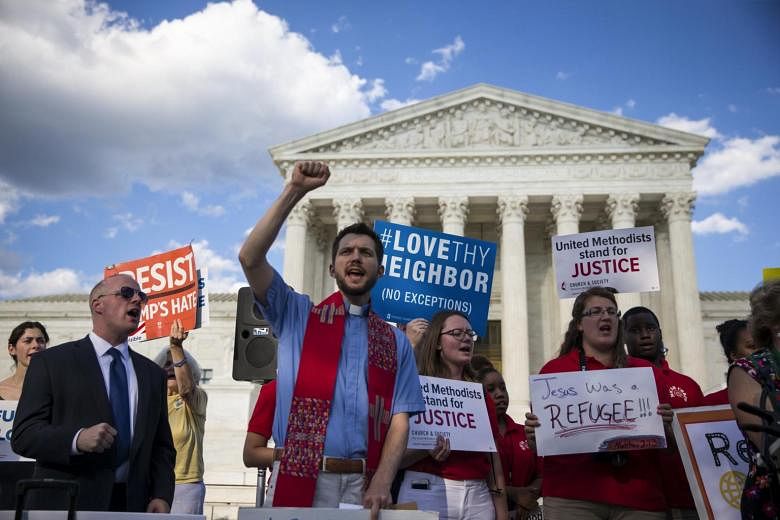The Trump administration is expected to put its new travel restrictions on refugees and migrants from six countries into effect on Thursday (June 29).
The move comes after the Supreme Court on Monday allowed a scaled-back version of United States President Donald Trump's travel ban to take effect.
The measures - which bar access to all refugees and to travellers from six mainly Muslim countries - are the latest attempt by the Trump adminstration to impose the ban after a series of judicial defeats.
Here is an explainer on what the ban is about.
1) What are the countries affected by the ban?
The six nations whose citizens are covered by the ban are Iran, Libya, Somalia, Sudan, Syria, and Yemen.
2) How did the ban come about?
The ban came about after Trump campaigned for "a total and complete shutdown" of Muslims entering the US during the 2016 US presidential race.
Trump had issued the original executive order on Jan 27 without warning, saying it was needed for national security amid rising international concern about attacks carried out by Islamist militants.
The ban has since become a key signature policy of Trump's presidency, even as it has come under opposition by critics who decry it as discriminatory. Because it applies selectively to mainly Muslim countries, critics say it violates the US Constitution's ban on religious discrimination. Opponents also argue that no one from the affected countries had carried out attacks in the US.
In the countries affected, the ban has also stirred anger and confusion among would-be visitors worried about the impact on their travel plans and futures.
3) Why has the ban taken so long to proceed?
The ban has gone through various iterations. The January order had temporarily barred travellers from seven Muslim-majority countries (Iran, Iraq, Syria, Yemen, Somalia, Sudan and Libya) from entering the US for 90 days. It also suspended the US refugee resettlement program for 120 days while banning refugees from Syria indefinitely.
But that January order quickly ran into trouble, causing travel chaos at airports in the US and abroad, until it was blocked by the courts less than a week later.
After the initial legal setback for the ban, the White House made slight revisions, deleting Iraq from the list and removing an indefinite ban on Syrian refugees. But the March 6 executive order too was later shot down by the courts.
4) Why has the ban now been allowed to proceed?
The US Supreme Court on Monday revived parts of the ban, allowing it to go into effect for people with no strong family or business ties to the US. That decision essentially endorsed the Trump administration's contention that the president deserves greater deference from the courts on national security matters.
The court had said the travel ban will go into effect "with respect to foreign nationals who lack any bona fide relationship with a person or entity in the United States" but did not specify exactly what that means.
Monday's Supreme Court decision comes after the Justice Department on June 1 filed an emergency application to the court, urging it to undo two previous lower court rulings blocking the ban.
5) Who will be affected by the ban?
Guidelines issued by the US State Department on Wednesday said visa applicants from the six countries must have a close US family relationship or formal ties to a US entity.
Under the guidelines, anyone who is a parent, spouse, child, adult son or daughter, son-in-law, daughter-in-law or sibling - including step siblings and other step family relations - will be exempted from the ban.
Those are who are not exempted include grandparents, grandchildren, aunts, uncles, nieces, nephews, cousins, brothers-laws and sisters-in-law, fiances, and any other "extended" family members.
According to the guidelines, examples of what might constitute a bona fide relationship with a US entity broadly include:
- Those eligible for student visas
- Those eligible for family or employment-based immigrant visa applications
- Workers who have accepted an offer of employment from a company in the US
- Lecturers invited to address an audience in the US
The court also imposed the same rules for refugees as it did for those seeking entry from the six aforementioned countries. Refugees who have some connection to the US may not be summarily blocked from entry; those who have no connection to the US may be blocked from entry.
6) When will it take effect?
Bloomberg News reported that implementation would begin at 8pm local time (8am Singapore time on Friday), in order to provide embassies and consulates around the globe prior guidance on how to enforce the ban.
7) What's next for the ban?
The decision closed five months of legal wrangling, and the Supreme Court will take up the case when it returns in October from its summer recess.
But as agencies await clarification on the partial ban's implementation, some anticipate legal battles will persist. Conservative Justice Clarence Thomas, who wanted the ban implemented for anyone from the six countries, wrote Monday he fears the court decision "will prove unworkable." It "will invite a flood of litigation until this case is finally resolved on the merits, as parties and courts struggle to determine what exactly constitutes a 'bona fide relationship'."
SOURCES: REUTERS, AFP, BLOOMBERG, BBC, ASSOCIATED PRESS, WASHINGTON POST

